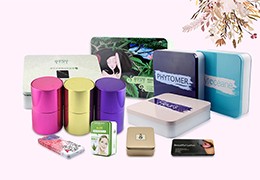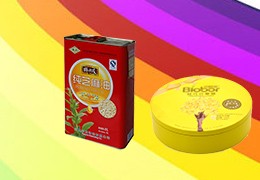What exactly makes...
Tin can production and printing inspection process
Quality inspection of tin can printing appearance:
Tin can color printing surface inspection requirements:
A. The color registration is accurate, the pattern is beautiful, the text is clear, complete, not deformed, there is no obvious blur, the font has no double shadows, missing pens, broken lines, etc.; there should be no obvious color difference between the sheets and the bar code is clear.
B. The surface should be smooth, free of coarse grains, strict wire drawing, scratches, etc., no scratches on the main parts, and no more than three minor scratches on the minor parts. Visual inspection

Note: The main part refers to the pattern, text, mark and bar code that reflect the theme on the screen of the printed matter. Minor scratches means that there is no iron scratch on the surface of the printed matter and no more than 0.3mmX 20mmo
Inspection requirements for tin can coating surface:
a. The film surface should be smooth and flat, the color should be basically the same, no molten tin, no coking. Melting tin or coking is a serious defect.
b. The coating film is allowed to have non-penetrating scratches. When the length of the tired mark does not exceed 500mm, it is a serious defect. Should exceed 250mm,
c. The coating film is allowed to be in three or less areas (50X50mm2), each with 5 or less impurity points with a maximum length of 0.5mm. The coating film is allowed to have no more than 3 bubbles with a diameter greater than 2rmi, and less than 3 areas are allowed.
In the domain (50X50mm2), each area contains no more than 10 dispersed bubbles with a diameter smaller than a Gap and larger than 0.2rmi. When the above-mentioned areas with dispersed bubbles exceed 5, it is a serious defect.
d. Missing or thin edges, the upper and lower edges along the printing direction should not exceed 3mm, and the left and right edges should not exceed 2mm. No more than 3 piles with a diameter of less than 5mm are allowed. Longitudinal plain iron is not allowed to leave blank strips: The paint iron used for resistance welding cans is never allowed to strip in the longitudinal blanks, because the strips will cause the resistance to increase and cause the welding to breakdown, and may damage the welding wheel of the welder. When printing and coating the blank, the error of the position and width of the blank should not exceed 1.0mm, otherwise it is a serious defect.
Surface hardness of tin can color printing surface

1) Tin can surface hardness test
, Purpose: To test the scratch performance of the color printing surface coating film through this test.
,Testing method:
1. Cut 3 pieces of tin can samples.
2. Take a 2H pencil and sharpen the pencil into a column shape.
3. Use a sharpened pencil to form a 45° angle with the sample and push forward forcefully. Result judgment: Observe the pencil scratch on the sample, if the scratches are not more than two places (including 2
Place), that is, reach the standard hardness of 2H. The surface hardness of the coating film is required to be no less than 2H.
2), detect tin can coating film thickness
:·Objective: To detect the thickness of the coating film through this test.
experiment method:
1. Cut 3 pieces of 50X50mm2 sample (not used for inspection within 25mm of the edge), use acetone to remove the outer coating layer, let it dry naturally, and weigh it with an electronic balance, accurate to 0.0001g
2. Prepare a 3%-5% sodium carbonate solution with steamed water at a temperature of 90-95°C, insert the sample into the solution with the test piece as the cathode and the stainless steel plate as the anode, and conduct electricity under 4~6V DC voltage. Free the membrane. After the film is loose, it can be pulled off with inserts. The surface should not become severely black after peeling off. After all is taken off, quickly take it out, wash, dry, and accurately weigh (accurate to 0.0001g). Calculate as follows: coating thickness (g/m2) 2 [(W-W2)/s] X1000000 where: W ! -The weight of a sample before stripping (g) W2-the weight of the sample after stripping (g); take the average of the measurement results of three samples.
Boiled test tin can surface adhesion
Purpose: To detect the adhesion of the inner coating film through this test.
·Detection method:
The tin can was cut to take 3 samples of 25X110mm, and scored on the paint film adhesion scratcher.
2. Use the American 3M-610 tape with a width of 15mm to stick it on the scratches of the coating film, and press it firmly with your index finger and palm.
3. Quickly tear off the tape from the coating film, and determine the level of adhesion of the test piece according to how much the coating film is torn off:
Level 1
Level II
Level III
Level IV: The coating film does not fall off at all; the coating film falls less than 10%; the coating film does not fall off
Class V: more than 25%: no more than 50% of coating film peeling: no more than
Class VI: 75%; coating film falling off does not exceed 90%;
4. Take the arithmetic average of the three test piece levels as the sample adhesion level. Result
Fixed: For A products (classified by film thickness), the adhesion is not lower than III; B and C products should not be lower than II.
tin cans acid resistance test
Purpose: To test the acid corrosion resistance of the inner coating film through this test.
Detection method:
1 Cut 6 pieces of HX100X25mm specimens, repeatedly fold them into squares with a spacing of 3mm, and put them in 5% (for A and B products) or 3% (for C products)
Acetic acid solution in a sealed container.
2. Put the test container in the autoclave, heat it up to 12VC, continue to maintain the pressure for 30 minutes, exhaust and reduce the pressure to cool, take out the sample, wash and straighten, observe the change of the coating film. Result requirements: The coating film with good acid resistance should be free of corrosion, peeling, and discoloration.
Tin can anti-sulfur detection
Purpose: To test the sulfur resistance of the inner coating film through this test.
Inspection method: Note: For canned foods that contain protein content, this test must be done. For example: beverages, canned food
1. Cut out 6 samples of 100X25mm, and fold them into squares with a spacing of 10mm. (The two chemical solutions are put into a sealed container containing the prepared chemical solution. Recipe
as follows)
a. Formulation 1: 0.05% (m/v) sodium sulfide solution with 3% (v/v) acetic acid adjusted to pH 6.0.
b. Formulation 2: The mixed solution of cysteine hydrochloride (0.5g/L), potassium dihydrogen phosphate (3.6g/L), and disodium hydrogen phosphate (7.2g/L) is diluted to 1000 mL of mixed solution.
2. Put the test container in the autoclave, heat it up to 121°C and keep the pressure for 30 minutes, exhaust and reduce the pressure to cool down, take out the sample, wash and straighten it, observe the coating and discoloration of the sample. The result is judged: the coating film with good sulfur resistance should have no obvious vulcanization spots and no peeling
Tin can anti-impact test
Purpose: To understand the internal machining performance of the color printing surface and the coating surface through this test.

Detection method:
1. Cut 6 pieces of 50X120mm sample from the designated part of the tin can, and test with the paint film impact tester.
2. The test height of the inner coating film surface is 90mm, the test height of the outer seal surface is 60mm, and the test height of the primer is 50mm. After the impact, observe whether the cap coating film is peeling off or cracking.
3. Tank body: no deformation, complete flanging, no obvious corrosion, no pollution, no peculiar smell.
Tin can making process inspection
1. Tin can crimping detection: smooth and even, there should be no quick mouth, false crimping, big collapse in the crimping part, and there should be no crimping incomplete, crimping teeth, crimping chipping, filling extrusion, sharp edges And other defects.
2. Tin can weld: flat and smooth, no cold welding, no holes, no splash points on the inside of the weld, and the sum of tailing and dislocation at the end of the weld is not more than 0.5mm, and the repainting is complete.
3. Neck flanging: uniform and smooth, no deformation, no serious neck wrinkles.
Avoid damage to the coating film when making tin cans
(1) The coating film is slightly damaged. Scratches on the surface of the tin layer will increase the micropores of the coating film, but it has little effect on the tank wall corrosion of general corrosive products, especially for the plain iron and top of the tank. Bottom cover
:·Canned fruit in syrup with coating iron, provided by the tin-melting reaction on a large area of the can body
The cathodic protection effect of the coating film on the bottom cover will not cause corrosion problems on the tin layer at the slight scratches.
(2) The coating film in the paint tin can is severely scratched. When there is a tin leak or even an iron leak, the food penetrates the damaged defect part of the coating film and locally corrodes the tin or iron. As a result, the corrosion spots spread and the coating film falls off. Or continue to corrode deeply and perforate, both of which make food and beverage cans lose their commercial value. For example, Red Bull and Ketchup are products with a strong tendency to dissolve tin, which require high uniformity and compactness of the coating film. Therefore, if there is a serious scratch, the content will corrode with the tin in the incomplete part of the coating film, and to the surrounding area. Diffusion, as the iron also dissolves, the adhesion is reduced and the coating film falls off.

















Latest comments